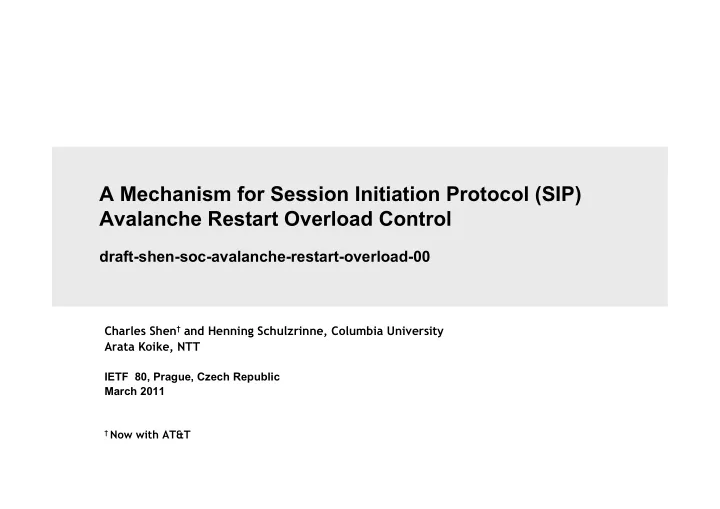

A Mechanism for Session Initiation Protocol (SIP) Avalanche Restart Overload Control draft-shen-soc-avalanche-restart-overload-00 Charles Shen † and Henning Schulzrinne, Columbia University Arata Koike, NTT IETF 80, Prague, Czech Republic March 2011 † Now with AT&T
Main updates Addressed comments from the mailing list by • Janet Gunn • Parthasarathi R Full diff available at http://tools.ietf.org/rfcdiff?url1=http://tools.ietf.org/id/draft-shen-sipping-avalanche- restart-overload-00.txt&url2=http://www.ietf.org/id/draft-shen-soc-avalanche-restart- overload-00.txt 3/29/11 2
Comments from Janet Gunn (I) http://www.ietf.org/mail-archive/web/sip-overload/current/msg00083.html Comment: overall concern about insufficient addressing of (negative) unintended consequences of this I-D. e.g., The 300 seconds default restart backoff interval is reasonable for avalanche restart, but not acceptable for “power off recovery” or a “connection loss recovery”. The enabling/disabling operations of client side backoff may be ignored by users; service providers may not be willing to enable the backoff at the cost of a slower power-up. 3/29/11 3
Comments from Janet Gunn (II) Revision: added the following texts in Section 1 “The method defined in this document is intended to be used for real avalanche restart situations, rather than just any local reboot or connection recovery. Therefore, the device employing this mechanism SHOULD try to estimate the nature of the restart incidents whenever possible.” NOTE: the concern is fully acknowledged; the texts are not a perfect solution there might not be a perfect solution, so the point is whether having this mechanism standardized will make things better than the status quo, where each vendor implements different things or nothing 3/29/11 4
Comments from Parthasarathi R http://www.ietf.org/mail-archive/web/sip-overload/current/msg00105.html Problem: REGISTER might not be the first message by UA. E.g., SUBSCRIBE could be the first message send by UA, in which case, SUBSCRIBE should have restart-timer rather than REGISTER. Revision: The parameter name has been changed to “RESTART-TIMER” from its original “REGISTER-RESTART”, other related texts have been updated accordingly. 3/29/11 5
Open issue: zero configuration entity Comments from Parthasarathi R http://www.ietf.org/mail-archive/web/sip-overload/current/msg00105.html Comment: “In case of zero configuration entity (SIP UA), DHCP discovery mechanism is used to discover the configuration server. The configuration server may use SIP or non-SIP mechanism. In these deployment, Entity will not have any configuration information within itself.” Discussion: Is this something that needs to be considered within the scope of this document? 3/29/11 6
Open Issue: document status Is there a common interest in the avalanche-restart overload problem (which is listed in the overload requirement RFC5390) within this WG? Should this I-D be considered towards a WG item? 3/29/11 7
Backup Slides Backup slides: Mechanism overview 3/29/11 8
Problem Statement SIP Registrar SIP UAs Avalanche restart (e.g., “Manhattan reboot”) causes simultaneous floods of certain messages (e.g., REGISTRAR, SUBSCRIBE, PUBLISH) which overloads the SIP server Very difficult for the UAs to choose an appropriate backoff time by themselves during avalanche restart 3/29/11 9
Solution Server estimates Restart-Backoff Timer Interval (RBIT) Server conveys RBIT to UAs during normal operation REGISTER SIP Registrar SIP UA SIP/2.0 200 OK Restart-Backoff: RBTI During avalanche restart • UAs backoff a randomly distributed time between 0 ~ RBTI 3/29/11 10
Recommend
More recommend